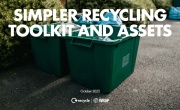California fights to tether caps to plastic bottles
Plastic bottle caps are some of the most pernicious items of litter found on the world’s beaches. In California, a simple measure to help address the problem has been proposed: attach the caps to their bottles so that the smaller part finds its way to recycling along with the bottle.

Data from the 2017 International Coastal Cleanup, an annual beach cleaning event organised by the ocean advocacy group Ocean Conservancy, reveals that plastic bottle caps were the third most collected item worldwide, making up almost six per cent of the total items collected. In the UK, this figure reached eight per cent.
The effects of errant plastics finding their way into the ocean is well-documented, with 90 per cent of all seabirds found to have ingested plastic, including bottle caps, which can be mistaken for food. When in the sea, plastic absorbs the chemical dimethyl sulfate (DMS) from algae, acting as a clarion call to birds which feed on algae-eating fish.
Democrat Assembly member Mark Stone, who proposed the bill, commented: “California has invested so much time and money in a process to make sure that plastic bottles get recycled instead of going into landfills or becoming litter. That’s why it’s so incredible that we still haven’t changed the law to make sure that the bottle caps get recycled as well. Discarded caps kill wildlife, damage ecosystems, and cost taxpayers millions of dollars to clean up.”
Bill 319 was abandoned without a vote at the start of February, with Stone’s efforts stymied by a lack of support from fellow Democrats and a campaign of resistance by the beverage industry focusing on the expense of implementing a tethered cap requirement. The American Beverage Association (ABA) apparently spent nearly $400,000 lobbying bills in 2017, including opposing Stone’s bill, and also contributed vast amounts to California lawmakers’ election campaigns.
Fredericka McGee, ABA’s vice president for California government affairs and operations, claimed: “The best way to improve on cap recycling is with public service reminders that get people to ‘Keep the Caps On!’ when discarding containers in recycling bins.” Given that plastic bottles are themselves more widely littered than the caps alone (bottles making up 11.4 per cent of all beach litter), Stone acknowledged that his proposal to tether the caps would need to come as part of a wider campaign to address plastic use and waste.

Stone has previously attempted to introduce other anti-waste measures, with a 2014 proposal to ban single-use cigarette filters (the single most collected item during 2016’s International Coastal Cleanup and in years before that) voted down by the Assembly. However, the bill was reintroduced earlier this month and is due to be heard by the Natural Resources Committee on 16 March. Stone argues that the damage to the environment caused by leftover cigarette butts is more significant than any supposed health benefits provided by using filters, which have not been conclusively proven to reduce the harm of smoking.
The previous iteration of the bill was described by one lobbyist as a “de facto ban on smoking in California”, so this version is likely to also face serious opposition.
Despite this, successful efforts to address waste have been growing in the state, with a statewide ban on plastic bags voted into being in 2016 following an amended ban on microbeads the previous year. A bill from Democrat Ian Calderon, due to go before the state’s Natural Resources Committee this month, proposes banning ‘dine-in restaurants’ from handing out disposable plastic straws unless they are requested, an approach that the Scottish Government could take when developing a mooted ban on straws.
Another of the world’s most-littered plastic items, straws have come under serious attack from campaigners over the past year, though Calderon been quick to maintain that the bill “is not a ban on plastic straws.” He continued: “It is a small step towards curbing our reliance on these convenience products, which will hopefully contribute to a change in consumer attitudes and usage.”









